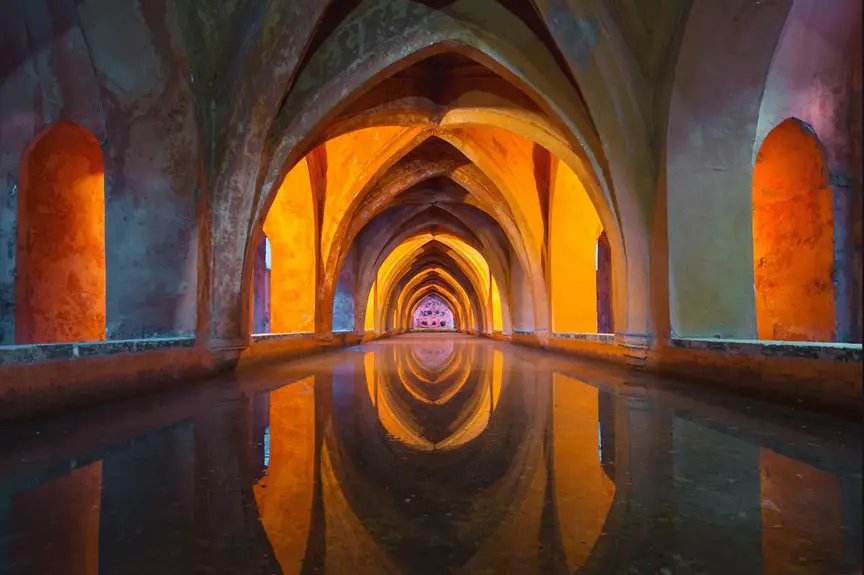Yes, your wall color can greatly affect your webcam lighting. Lighter colors reflect more light, brightening your appearance, while darker shades absorb light and may create a dim look. Cool colors like blue promote professionalism, but they can wash you out if not properly lit. Conversely, warm tones like beige create a cozy vibe and enhance your complexion. If you’re curious about how to optimize your setup further, there are plenty of tips available to explore.
Table of Contents
Key Takeaways
- Wall colors influence how light is reflected, impacting the brightness and overall ambiance during video calls.
- Light colors, like white or pastels, reflect more light, brightening your appearance on camera.
- Dark colors absorb light, resulting in a dimmer environment that may negatively affect webcam quality.
- Bold, saturated colors can create dramatic shadows, altering your on-camera presence and appearance.
- Soft blue tones enhance skin tones and reduce harsh shadows, making them ideal for video calls.
Understanding Color Theory
Understanding color theory is essential for creating the right ambiance in your space, especially when it comes to webcam lighting. Colors can influence moods and perceptions, affecting how you appear on camera.
Warm colors like red and orange can create a cozy atmosphere but may wash you out under certain lighting conditions. Cool colors, such as blues and greens, can evoke calmness but might also appear harsh if your lighting isn’t balanced.
Warm colors create coziness, while cool colors evoke calmness; both require careful lighting balance for the best effect.
Knowing how these colors interact with light helps you choose the best wall paint for your setup. Experimenting with color samples can aid in visualizing how they’ll look with your lighting.
Ultimately, the right wall color enhances your overall appearance and boosts your confidence during video calls.
The Role of Lighting in Video Calls
Good lighting can make all the difference during your video calls.
By using natural light and understanding how color temperature affects your appearance, you can enhance your presence on screen.
Let’s explore how these elements can improve your video call experience.
Importance of Natural Light
While you mightn’t think about it often, natural light plays an essential role in enhancing your appearance during video calls. Good lighting can make you look more vibrant and engaged, while poor lighting can cast unflattering shadows or make you appear washed out.
Position yourself near a window, if possible, to take advantage of soft, diffused sunlight. This can create a warm, inviting atmosphere that helps you connect better with your audience. Avoid harsh, direct sunlight, which can create glare and distort your image.
Color Temperature Impact
Color temperature greatly influences how you appear on video calls, affecting everything from skin tone to the overall mood of the conversation. Warmer temperatures (around 2700K-3000K) create a cozy, inviting atmosphere, which can enhance connection. Conversely, cooler temperatures (5000K-6500K) give a more professional look but might wash out your features.
Here’s a quick reference table to help you understand the impact of different color temperatures:
| Color Temperature | Mood | Appearance Impact |
|---|---|---|
| 2700K – 3000K | Cozy, Inviting | Soft, Warm Skin Tone |
| 4000K – 4500K | Neutral, Balanced | Natural Appearance |
| 5000K – 6500K | Professional | Bright, Crisp Look |
Choose wisely for your next video call!
How Wall Colors Reflect Light
The hue of your walls plays an essential role in how light interacts within your space. The color you choose can enhance or diminish the quality of light that bounces around the room, affecting your webcam lighting.
Here are three key ways wall colors reflect light:
- Light Colors: Shades like white or pastels reflect more light, brightening the space and creating a more vibrant atmosphere.
- Dark Colors: Deep hues absorb light, potentially leading to a dimmer environment and less flattering webcam results.
- Saturation Level: Bold, saturated colors can create dramatic shadows, impacting how your features appear on camera.
Warm vs. Cool Tones: The Impact on Appearance
Choosing between warm and cool tones can greatly impact how you appear on camera.
Warm tones, like soft yellows and oranges, can create a cozy, inviting atmosphere. They tend to soften your features and give your skin a healthy glow, making you seem approachable.
Conversely, cool tones, such as blues and greens, offer a more professional and modern vibe. They can enhance clarity and focus, but might also wash you out if not balanced with proper lighting.
Depending on your desired impression, consider how these tones interact with your lighting setup.
Ultimately, the right choice can help you present your best self, whether you’re in a casual chat or a formal meeting.
The Psychology of Color in Virtual Settings
When you enter a virtual meeting, the colors around you can subtly influence how others perceive your mood and professionalism. Your wall color doesn’t just affect your appearance; it shapes the emotional tone of the conversation.
The colors in your virtual meeting space impact perceptions of your mood and professionalism, shaping the conversation’s emotional tone.
Here are three key psychological effects of color:
- Blue: Evokes calmness and trustworthiness, making it ideal for professional settings.
- Yellow: Encourages optimism and creativity, but too much can be overwhelming.
- Red: Signals energy and urgency, which can be motivating but may also create tension.
Being aware of these effects can help you create an environment that enhances your presence during virtual meetings. Choose your colors wisely to convey the right message and vibe!
Tips for Choosing the Right Wall Color
How can you select the perfect wall color for your virtual space? First, consider the mood you want to create. Soft blues and greens promote calmness, while bold reds and yellows energize.
Next, think about your skin tone; warmer colors can enhance your complexion, while cooler tones might wash you out. Test samples on your wall to see how they look at different times of the day.
Remember to factor in your furniture and decor—colors should complement each other. Finally, avoid overly dark or bright colors, as they can distort your webcam image.
Aim for a balanced shade that reflects your personality and works well with your lighting. Choose wisely, and your virtual space will shine!
Using Lighting to Enhance Your Wall Color
Proper lighting can dramatically elevate the appearance of your wall color by enhancing its light reflection properties.
You’ll notice that different color temperatures can either warm up or cool down your space, affecting how your chosen hue looks on camera.
Light Reflection Properties
While selecting the right wall color is essential, the way light interacts with that color can greatly enhance your space.
Understanding light reflection properties can help you optimize your webcam lighting, making you look your best on camera.
Here are three key aspects to evaluate:
- Light Color: Lighter wall colors reflect more light, creating a brighter atmosphere that can improve your webcam image.
- Finish Type: Glossy finishes reflect light differently than matte finishes. A satin or eggshell finish can strike a balance, reducing glare while maximizing brightness.
- Room Size: In smaller spaces, light colors can make the room feel larger and more open, enhancing your overall appearance during video calls.
Color Temperature Influence
The right color temperature of your lighting can greatly enhance the effect of your wall color, transforming your space and improving how you appear on camera.
Warm lighting, around 2700K to 3000K, can make your walls appear cozier and more inviting, especially if they’re painted in warmer hues.
On the other hand, cooler lighting, around 4000K to 5000K, can create a more vibrant, energizing atmosphere, making cooler wall colors pop.
Choosing the right bulbs can also prevent unwanted color casts, ensuring your walls look true to life.
Experimenting with different temperatures helps you find the perfect balance that complements your wall color, enhancing both your environment and your overall presence during video calls.
Contrast and Clarity
To enhance the visual appeal of your space, consider how lighting can create contrast and clarity against your wall color.
The right lighting not only highlights your walls but also improves your webcam image quality. Here are three ways to effectively use lighting for maximum impact:
- Choose the Right Bulbs: Opt for daylight bulbs to brighten up the room and make colors pop.
- Position Your Lights: Place lights at angles that illuminate your face while minimizing shadows.
- Use Accent Lighting: Incorporate floor or table lamps to draw attention to your wall color, creating depth and interest.
Testing Your Setup: Finding the Perfect Balance
How do you guarantee your webcam setup looks its best? Start by testing different wall colors and lighting conditions. You want to create a perfect balance that enhances your appearance without overwhelming the scene. Adjust your camera settings and observe how various colors reflect light.
Here’s a simple table to help you track your findings:
| Wall Color | Lighting Type | Webcam Quality |
|---|---|---|
| Light Blue | Natural Light | Sharp and Bright |
| Dark Gray | Soft Light | Warm and Muted |
| White | LED Light | Crisp and Clear |
Experiment with these combinations to see what works best for your unique setup. Remember, small tweaks can make a significant difference!
Real-Life Examples of Wall Color Effects
Finding the right wall color can dramatically impact your webcam experience, as real-life examples illustrate.
The right wall color can significantly enhance your webcam experience, transforming your on-camera presence.
You might be surprised by how different hues can change your appearance on camera. Consider these three examples:
- Soft Blue: This color can create a calming effect, enhancing your natural skin tone and reducing harsh shadows.
- Bright White: While it reflects light well, it can wash you out if you’re not careful with your lighting setup.
- Warm Beige: This neutral shade adds warmth, making you look more approachable and lively without overpowering your features.
These examples show how intentional wall color choices can improve your on-camera presence, making your video calls feel more professional and engaging.
Frequently Asked Questions
Can Dark Wall Colors Make Me Look More Shadowed on Camera?
Yes, dark wall colors can make you look more shadowed on camera. They absorb light, reducing brightness and contrast, which may result in a less flattering appearance during your video calls or recordings.
Do Patterns on Walls Interfere With Webcam Image Quality?
When it comes to patterns on walls, they can make your webcam image look like a mixed bag. Busy designs might distract the camera, making it tough for you to shine during video calls.
How Do Wall Colors Affect the Perception of My Skin Tone?
Wall colors can dramatically influence how your skin tone appears on camera. Lighter colors might brighten your complexion, while darker shades can create a more muted look. Choosing the right hue guarantees you look your best.
Should I Consider Wall Color When Using Virtual Backgrounds?
When you’re setting up your virtual background, think about wall color. It can impact how your background looks on camera. A lighter shade might brighten things up, while darker tones could create a moody vibe.
Can Wall Color Influence My Mood During Video Calls?
Your wall color can greatly influence your mood during video calls. Bright colors can energize you, while softer shades can create a calming atmosphere. Consider what vibe you want to project in your conversations.




